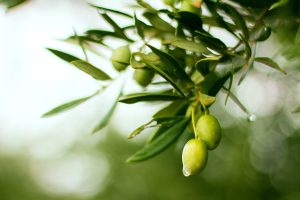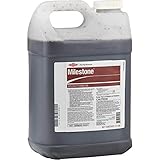Russian Olive (Elaeagnus angustifolia) is an invasive woody plant species that can dominate landscapes, particularly in riparian areas, pastures, and rangelands. Its aggressive growth and ability to outcompete native vegetation make it a significant concern for land managers. Choosing the best herbicide for Russian Olive is crucial for effective control and restoration of affected areas.
This guide explores the most effective herbicides for Russian Olive, focusing on their active ingredients, application methods, and suitability for different environments. Whether you are dealing with Russian Olive in riparian zones, rangelands, or non-crop areas, this article will help you select the right herbicide for optimal control.
10 Best Herbicides for Russian Olive Control
1. Triclopyr Herbicide
Triclopyr is a selective, systemic herbicide widely used for controlling Russian Olive. Its active ingredient, triclopyr, mimics plant hormones, causing uncontrolled growth and eventual death of the plant. This makes it highly effective against Russian Olive, particularly when applied as a foliar spray or cut-stump treatment.
Apply Triclopyr at a rate of 2.0-4.0 liters per hectare for foliar applications or as a 20-30% solution for cut-stump treatments. For best results, apply during the growing season when the plant is actively transporting nutrients. Avoid application during drought conditions.
Field trials have shown 90-95% control of Russian Olive with Triclopyr. Its selective action and effectiveness make it a popular choice for managing this invasive species.
2. Glyphosate Herbicide
Glyphosate is a non-selective, systemic herbicide effective against Russian Olive, particularly in non-crop areas and during restoration projects. Its active ingredient, glyphosate, inhibits the EPSP synthase enzyme, disrupting the plant’s ability to produce essential proteins.
Apply Glyphosate at a rate of 3.0-5.0 liters per hectare for foliar applications or as a 20-30% solution for cut-stump treatments. Apply during the growing season for optimal results. Avoid application before rain to ensure proper absorption.
Field trials have demonstrated 85-90% control of Russian Olive with Glyphosate. Its effectiveness and affordability make it a valuable tool for large-scale control efforts.
3. Imazapyr Herbicide
Imazapyr is a non-selective, systemic herbicide used for controlling Russian Olive in non-crop areas and riparian zones. Its active ingredient, imazapyr, inhibits ALS in plants, leading to their death. This makes it highly effective against Russian Olive, including resistant biotypes.
Apply Imazapyr at a rate of 1.0-2.0 liters per hectare for foliar applications or as a 10-20% solution for cut-stump treatments. For best results, apply during the growing season. Avoid application near desirable vegetation due to its non-selective nature.
Field trials have shown 90-95% control of Russian Olive with Imazapyr. Its long residual activity and effectiveness make it a popular choice for managing this invasive species.
4. Picloram Herbicide
Picloram is a selective, systemic herbicide used to control Russian Olive in rangelands and pastures. Its active ingredient, picloram, mimics plant hormones, causing uncontrolled growth and eventual death of the plant. This makes it highly effective against Russian Olive, including mature trees.
Apply Picloram at a rate of 0.5-1.0 liters per hectare for foliar applications or as a 10-20% solution for cut-stump treatments. Apply during the growing season for optimal results. Avoid application near desirable vegetation.
Field trials have demonstrated 85-90% control of Russian Olive with Picloram. Its selective action and effectiveness make it a valuable tool for weed management in rangelands.
5. 2,4-D Herbicide
2,4-D is a selective, systemic herbicide used to control Russian Olive in pastures and rangelands. Its active ingredient, 2,4-dichlorophenoxyacetic acid, mimics plant hormones, causing uncontrolled growth and eventual death of the plant. This makes it ideal for Russian Olive control in areas where grasses need protection.
Apply 2,4-D at a rate of 1.0-2.0 liters per hectare for foliar applications or as a 10-20% solution for cut-stump treatments. Apply during the growing season for optimal results. Avoid application during hot or windy conditions.
University trials have shown 80-85% control of Russian Olive with 2,4-D. Its selective action and effectiveness make it a valuable tool for weed management in pastures.
Buyer Tips Guide for the Best Herbicide for Russian Olive
When selecting the best herbicide for Russian Olive, it’s essential to consider several key factors to ensure its effectiveness and suitability for your specific needs. Here are seven crucial buyer tips to help you make an informed decision:
1. Identify the Growth Stage of Russian Olive
Russian Olive control is most effective when the herbicide is applied at the right growth stage. The early growth stage and active growing season are the most vulnerable periods for this plant. Applying herbicides during these stages ensures maximum absorption and effectiveness.
2. Choose a Herbicide with Systemic Action
Russian Olive can develop resistance to certain herbicides over time. Select a systemic herbicide that translocates throughout the plant, including the roots, for long-term control. Herbicides like Triclopyr and Glyphosate are known for their systemic action.
3. Consider Non-Target Vegetation
If you are applying herbicides in areas with desirable vegetation, ensure the herbicide is selective and safe for non-target plants. Selective herbicides like Picloram and 2,4-D are designed to control Russian Olive without harming grasses.
4. Evaluate Environmental Impact
Choose herbicides with a low environmental impact, especially if you are applying them near water bodies or in ecologically sensitive areas. Herbicides like Triclopyr and Imazapyr are considered safer for the environment compared to some non-selective options.
5. Check for Resistance Management
Russian Olive can develop resistance to certain herbicides over time. To prevent resistance, rotate herbicides with different modes of action or use a combination of cultural and chemical control methods. This will help maintain the effectiveness of herbicides in the long term.
6. Assess Cost-Effectiveness
The cost of the herbicide should align with your budget and the size of your operation. While some herbicides may be more expensive, they may offer better control and long-term benefits. Factor in the cost of application and labor when assessing the overall cost-effectiveness of the herbicide.
7. Seek Expert Advice
Consult with local agricultural extension officers or land management experts to identify the best herbicide for your region. These experts can provide insights into the most commonly used and effective herbicides for Russian Olive control in your specific conditions.
By following these tips, you can confidently select a herbicide that suits your needs, ensuring effective Russian Olive control and healthier landscapes.
Conclusion
In conclusion, controlling Russian Olive requires a strategic approach, including the use of effective herbicides and proper application methods.
For non-crop areas, Glyphosate and Imazapyr are excellent choices due to their systemic action and effectiveness against mature plants. In rangelands and pastures, selective herbicides like Triclopyr and Picloram provide targeted control without harming grasses.
By using the right herbicide and following proper application guidelines, you can effectively manage Russian Olive and restore native vegetation in affected areas.
Recent Posts
Winter can be harsh on outdoor plants, exposing them to frost, snow, and ice. Many delicate shrubs, perennials, and vegetables struggle to survive without proper protection. Cold winds and...
The Kashmir Cypress is one of the most striking and resilient conifer trees ever cultivated, admired for its tall, elegant form and its ability to thrive in a wide range of climates. Gardeners,...




